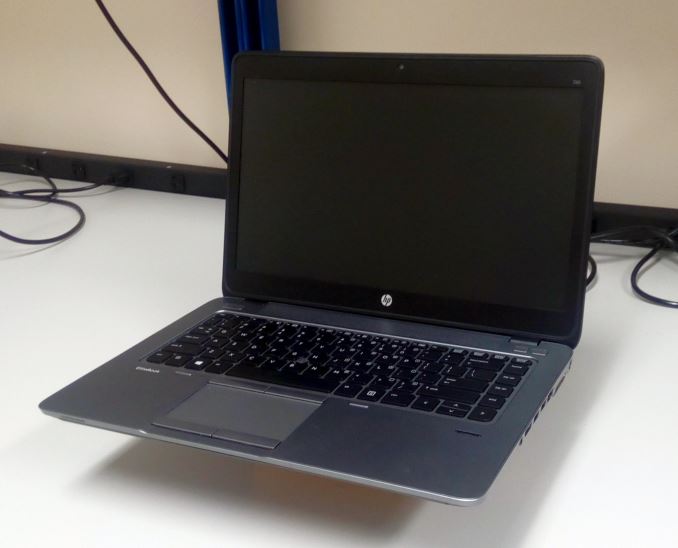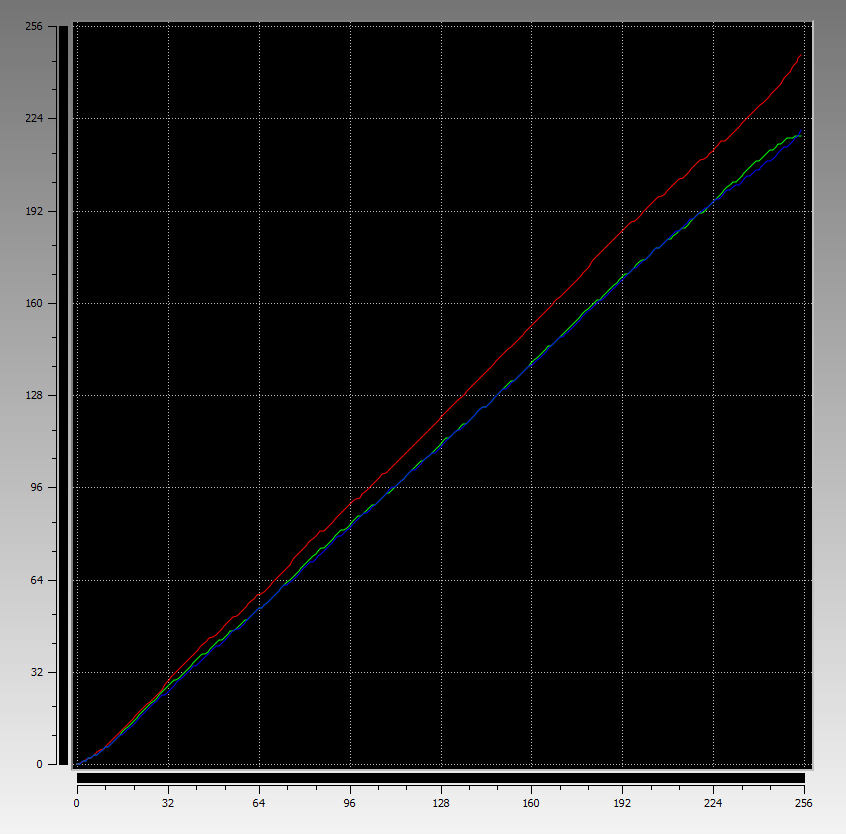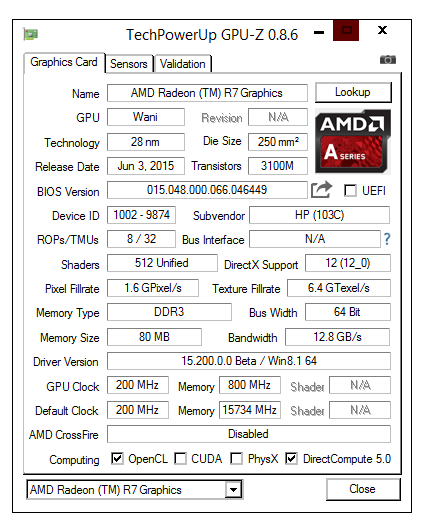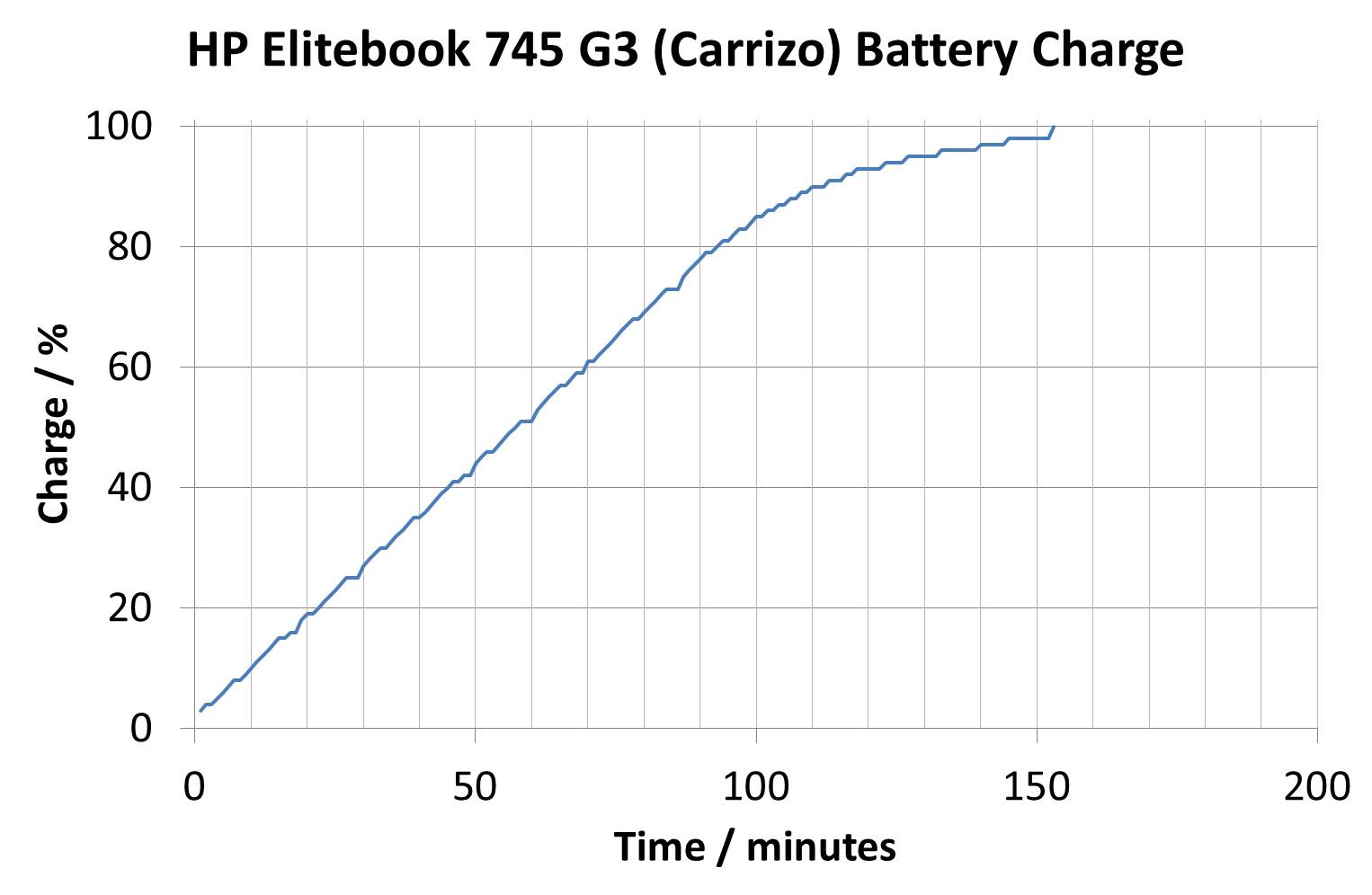Who Controls the User Experience? AMD’s Carrizo Thoroughly Tested
by Ian Cutress on February 4, 2016 8:00 AM EST#2 The HP Elitebook 745 G3 (Carrizo, PRO A12-8800B)
The Carrizo Elitebook 745 G3 looks practically identical to the Kaveri based 745 G2, so there’s no need to cover the visuals again, but the internals here cause a lot of talking points.
| HP Elitebook 745 G3 (Carrizo) Specifications | |
| Size and Resolution | 14-inch, 2560x1440 IPS |
| Processor | AMD PRO A12-8800B Dual module, 4 threads 2.1 GHz Base Frequency 3.4 GHz Turbo Frequency |
| Graphics | Integrated R7 512 Shader Cores 800 MHz maximum frequency GCN 1.2 |
| TDP | 15W |
| Memory | 4 GB in Single Channel Operation 1 x 4GB at DDR3L-1600 C11 2 SO-DIMM Slots |
| Storage | 128GB SSD |
| Battery Size | 45.76 Wh 3 cell Li-Po design, rated to 8.5 hours |
| WiFi | Broadcom Broadcom BCM943228Z 802.11ac 2x2 |
| Optical Drive | No |
| Dimensions | 13.3 x 9.3 x 0.74 in (non-touch) 13.3 x 9.3 x 0.80 in (touch) |
| Weight | 3.41 lb (non-touch) 3.76 lb (touch) |
| Webcam | 1280x720 |
| Other Features | Gigabit Ethernet 4 x USB 3.0 DisplayPort VGA Smart Card Reader |
| Operating System | Windows 8.1 |
| Website Link | link |
The G3 is almost the top premium model Carrizo you can buy, coming in at nearly $1100 if you put up the cash for the top model, which includes as much memory and storage you can fit in. For our unit, it came in at a more modest $700 ($700 for the base model, this was more $1100), which is more in-line with what price point AMD originally expected the Carrizo platform to hit. This is the first notebook with AMD’s new A12 line of processors, with this one being the PRO A12-8800B. This is a 15W part running at a base frequency of 2.1 GHz with a turbo mode up to 3.4 GHz. Any mobile APU in the A12 category has a full complement of 512 streaming processors similar to the FX mobile parts or A10 desktop parts, and the A12 runs these at 800 MHz. Unfortunately this is slightly crippled by only having the equivalent of one memory module in play, a single 4GB DDR3L-1600 module. It is dual channel capable if another is installed.
One of the big plus points with this model is the display, in comparison to the dire one on the G2, but this probably explains the majority of the cost in this 745 G3. With a 2560x1440 IPS display running a high contrast ratio (1422), it did have the best display out of what we tested for this piece. This is matched by the Wi-Fi solution, which had Broadcom’s BCM943228Z module which is an 802.11ac module in the M.2 form factor. One of the general feelings I had from the engineers here is that laptop Wi-Fi will all migrate to M.2 eventually on the understanding of better power control and form factor.
G3 Specific Testing
The 2560x1440 display varied from 0.21 nits all the way up to 297, nearly reaching the 300 mark but resulting in a 1422 contrast ratio. The white point was high, marking it up at 6657K.
While the color accuracy calibration graph looks as if the red line is the one going off on its own, it is actually the red line that is most accurate – we’re expecting a straight line through (0,0), (32,32), (64,64) and so on and while the red line is below most of these points, it isn’t as low as the green or blue.
The CPU-Z outlay shows the new FP4 socket with Carrizo over Kaveri, as well as having the full 12 compute units with those 512 SPs in tow.
On the integrated graphics side, despite the R7 graphics in there, the important element is that memory bandwidth running at 12.8 GB/s due to the single channel memory in use. We can also see the GPU clock running at 200 MHz idle, lower than the Kaveri implementation, which has power benefits.
With the 745 G3 we were able to do a run down on our light battery test, as well as run through some charge numbers.





















175 Comments
View All Comments
jabber - Friday, February 5, 2016 - link
You'd think someone was paying the OEMs to hamstring these machines...Some odd facepalm design decisions there.
CajunArson - Friday, February 5, 2016 - link
Somebody *IS* paying OEMs to hamstring the machines: Customers. Customers who want cheap products that is.AMD makes its reputation as: "Intel is too expensive! We're cheap!" Don't act all shocked and surprised when the rest of the components in the system end up being the cheap components too.
As Anand just pointed out with that price comparison, even with all the cheaping out you can still see a whopping $8 price advantage for AMD on comparably configured notebooks.
tipoo - Friday, February 5, 2016 - link
Seriously, some weird stuff. No dual graphics when the chips are almost the same performance? Single channel RAM? What the hell.Midwayman - Friday, February 5, 2016 - link
I feel like AMD needs to pull a MS surface or Nexus and put out a reference model to show OEMs how it is supposed to be done. If all OEMs will do is put out a half assed effort, at least then they can just copy the reference design and it will work well.bojblaz - Friday, February 5, 2016 - link
+1... You're right, OEMs have pissed off MS and Google enough for them to go solo. AMD could totally follow suitInquisitorDavid - Friday, February 5, 2016 - link
Sure, if they had the money to. As it stands, the company is now banking on Zen to rescue them. I don't think they can afford to invest in going solo with device designs, at least not right now.TheinsanegamerN - Thursday, February 11, 2016 - link
They could team up with the likes of MSI or Clevo. Both have done good AMD laptops in the past.A 14 inch msi laptop with a 100wh battery, a 8800p, and 8gb dual channel ram would fetch a good price from those who want AMD laptops.
0razor1 - Friday, February 5, 2016 - link
Attn Ed: The HP Elitebook 745 G2GCN 1.0 in the text and then 1.1 in the grid.
Nice read BTW.
Ian Cutress - Friday, February 5, 2016 - link
Fixed! Thanks :)RationalHaterade - Friday, February 5, 2016 - link
Great write-up, Ian. This is enlightening, and the buoyant attitude at AMD might be saying a lot about what we can expect to see from the 2016/17 product releases.Speaking to Carrizo, I'm not sure they realized how badly they were hurting themselves when they elected to keep Kabini/Temash as single-channel designs and then provide OEMs a cheap out by making it pin-compatible with the big architecture. GCN has always been very bandwidth-dependent in every APU they've released. These single-channel setups have got to be really starving the SoC.
Either way, the performance picture points out what everyone already knows. Zen can't get to mobile quickly enough.